Executive Summary
F-15E Radar Modernization Program (RMP) developmental flight testing began in January 2011. The RMP demonstrated incremental progress towards operational effectiveness, suitability, and mission capability during developmental test activities throughout FY11. IOT&E is scheduled to begin in June 2012.
The Air Force Operational Test and Evaluation Center (AFOTEC) conducted an Operational Assessment (OA) from January 5 through April 29, 2011, to assess RMP progress towards operational effectiveness, suitability, and mission capability in support of the program’s Milestone C decision.
During the OA period, RMP demonstrated functional equivalence to the legacy F-15E radar in some of the system’s air-to-air modes and made progress in meeting air-to-air detection and track capabilities under limited and highly scripted test conditions. However, short range air-to-air capabilities and air-to-ground capabilities were insufficiently mature to demonstrate functional equivalence during FY11 developmental flight test.
Two significant shortfalls were uncovered during FY11 developmental testing: unanticipated electromagnetic interference (EMI) between the radar and aircraft Ultra High Frequency (UHF) radio, and aircraft Environmental Control System (ECS) component failures and in-flight cautions associated with RMP system integration on the aircraft. Resolution of these shortfalls is ongoing and should be completed prior to IOT&E.
 The F-15 C/D fighter planes, which first emerged in the mid-70s, are primarily engineered for air-to-air combat and air superiority missions. The F-15E strike eagle aircraft, first produced in the late 1980s, combine air-to-air attack technology with ground-strike mission ability.
The F-15 C/D fighter planes, which first emerged in the mid-70s, are primarily engineered for air-to-air combat and air superiority missions. The F-15E strike eagle aircraft, first produced in the late 1980s, combine air-to-air attack technology with ground-strike mission ability.